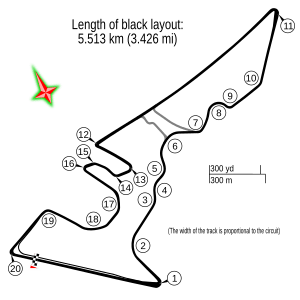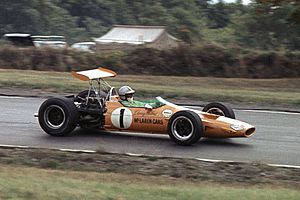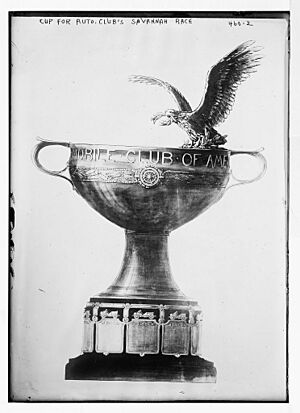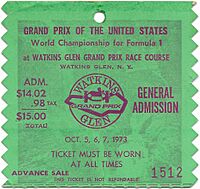United States Grand Prix facts for kids
| Circuit of the Americas | |
 |
|
| Race information | |
|---|---|
| Number of times held | 53 |
| First held | 1908 |
| Most wins (drivers) | |
| Most wins (constructors) | |
| Circuit length | 5.513 km (3.426 mi) |
| Race length | 308.405 km (191.634 mi) |
| Laps | 56 |
| Last race (2024) | |
| Pole position | |
|
|
| Podium | |
|
|
| Fastest lap | |
|
|
The United States Grand Prix is a famous car race that has been held many times since 1908. It was first called the American Grand Prize. This exciting race later became part of the Formula One World Championship, which is the highest level of car racing.
As of 2024, the Grand Prix has happened 53 times in ten different places across the United States. Since 2012, the race has mostly been held every year at the Circuit of the Americas in Austin, Texas. The only time it didn't happen was in 2020, because of the COVID-19 pandemic.
Contents
The Start of American Racing
Early Races and the Vanderbilt Cup
Long ago, a man named William Kissam Vanderbilt II was inspired by car races in Europe. He wanted to create similar exciting road races in the United States. His idea led to the Vanderbilt Cup, a popular race on Long Island in New York. Both American and European drivers came to compete.
However, these early races had problems with crowds. Sometimes, people got hurt, which led to the 1907 race being canceled. When racing returned in 1908, a new race called the American Grand Prize was created. It followed special rules from Europe. The first American Grand Prize was held in Savannah, Georgia.
The Grand Prize Era: 1908-1916
For the 1908 race, the Savannah Automobile Club made a longer track, about 25 miles long. The Governor of Georgia even sent state troops to help manage the crowds and keep everyone safe. This was to avoid the problems seen at the Vanderbilt Cup.
The first race had 14 European cars and six American cars. Famous car makers like Benz, Fiat, and Renault had teams there. On Thanksgiving Day, Louis Wagner won the race by a very close 56 seconds!
Even though the Savannah race was a success, the 1909 race was planned for Long Island. But it was canceled. The 1910 race also had problems, including serious injuries to spectators. Luckily, the Savannah club saved the race at the last minute. The track was shorter, and many European teams couldn't make it. American driver David Bruce-Brown won that year by a tiny 1.42 seconds!
In 1911, the race returned to Savannah, and the Vanderbilt Cup joined it. These races were held together until 1916. However, people started to complain about closing roads and using state workers for the event. Sadly, there were also accidents during practice, including one that caused a death. Despite this, American drivers did very well, and Bruce-Brown won again.
By 1912, Savannah decided not to host the race anymore due to public pressure. Milwaukee, Wisconsin, became the new host. A narrow, 7.88-mile track was set up. More tragedy struck when David Bruce-Brown was killed in a practice accident. In the race, Ralph DePalma crashed on the final lap, ending any chance of another race in Milwaukee.
The Grand Prize wasn't held in 1913. In 1914, it moved to Santa Monica, California, near Los Angeles. The track had a straight section along the Pacific Ocean. American drivers did very well, with Eddie Pullen winning. In 1915, the race moved to San Francisco. Because of World War I in Europe, most drivers and cars were American. The race was very muddy due to heavy rain, but Dario Resta won easily. He also won the Vanderbilt Cup a week later.
The Grand Prize returned to Santa Monica in 1916. This was the last Grand Prize race for a long time. Road racing became less popular as oval track racing grew in the U.S.
The Indianapolis 500 and F1 Connection
After 1916, the Grand Prize stopped. American racing fans became more interested in oval track races. The famous Indianapolis 500 race kept a link to European racing by using similar rules for many years. From 1950 to 1960, the Indianapolis 500 was even part of the Formula One World Championship!
Formula One Comes to the USA
Sebring (1959) and Riverside (1958, 1960)
In 1957, Riverside International Raceway opened in California. It hosted a race called the "United States Grand Prix" in 1958, which attracted many top drivers.
A man named Alec Ulmann, who started the 12 Hours of Sebring endurance race in Florida, decided to bring a Formula One race to Sebring International Raceway in 1959. This race was called the "II United States Grand Prix." It was the final race of the season. New Zealand's Bruce McLaren won his first F1 race, becoming the youngest driver to win a Grand Prix at that time. He took the lead on the very last lap when his teammate, Jack Brabham, ran out of fuel! Brabham had to push his car across the finish line to get fourth place. This exciting finish helped Brabham and his Cooper team win the championships.
Even though the race was thrilling, it didn't make much money because Sebring was a bit isolated. So, in 1960, Ulmann moved the race to Riverside. Stirling Moss won that race, but again, it wasn't very popular.
Watkins Glen (1961–1980)
A New Home for F1
In 1961, a racing promoter named Cameron Argetsinger offered his track, Watkins Glen International, in upstate New York, to host the Grand Prix. The track was accepted, and Watkins Glen became the home of the United States Grand Prix for the next 20 years! It was known as the "Mecca" of American road racing.
The first race at Watkins Glen was a surprise win for Innes Ireland, his first F1 victory. Unlike the previous races, this one was very popular, with over 60,000 fans, and it made a profit. The teams were happy because they were paid in cash!

Exciting Races and Changes
In 1962, Jim Clark won for Lotus. Then, Graham Hill won the next three races in a row for BRM. Clark won again in 1966 and 1967. In 1968, American driver Mario Andretti started from the very front in his first F1 race, but he had to stop early. Jackie Stewart won that race. In 1969, Jochen Rindt got his first F1 win. Sadly, Graham Hill had a bad crash, breaking both his legs.
Watkins Glen often hosted races near the end of the season. To make them more exciting, organizers offered huge prize money. In 1969, the winner got $50,000!
The 1970s: Speed and Challenges
In 1970, a new driver from Brazil, Emerson Fittipaldi, won the race in only his fourth F1 start. It was a very emotional win for the Lotus team because their main driver, Jochen Rindt, had died earlier in the season. Rindt still won the championship that year, even after his death.
In 1971, the track was made much longer and more challenging. It became a favorite for drivers and fans. French driver François Cevert won his only Grand Prix that year, taking home a huge cash prize. In 1972, Jackie Stewart won again.
The 1973 race was supposed to be Jackie Stewart's last, as he had already won his third championship. But during practice, his teammate and friend, François Cevert, was tragically killed in a crash. Stewart and his team were so upset that they pulled out of the race. Swedish driver Ronnie Peterson won the race.
In 1974, the championship was decided at Watkins Glen. Emerson Fittipaldi won his second championship by finishing fifth. Sadly, another driver, Helmut Koinigg, died in a crash during this race. To make the track safer, a new chicane (a series of tight turns) was added in 1975.
James Hunt won in 1976, which helped him get closer to winning the championship. He won again in 1977 in the rain. In 1978, Carlos Reutemann won for Ferrari. In 1979, Gilles Villeneuve won a wet race.
By the late 1970s, the Watkins Glen track was getting old and bumpy. Drivers complained, and fans were sometimes rowdy. There were even reports of cars being burned in a section of the track called the "Bog." The track was resurfaced for the 1980 race, but it was the last United States Grand Prix held there. The race was canceled for 1981 because of money problems.
New Locations for the US Grand Prix
Phoenix (1989–1991)
After Watkins Glen, other Formula One races were held in the U.S. in places like Long Beach, California, Detroit, Dallas, and even a car park in Las Vegas. The Detroit race lasted the longest, from 1982 to 1988.
In 1989, the United States Grand Prix name returned, moving to a street circuit in Phoenix, Arizona. Drivers didn't really like the Phoenix track because it had too many slow, 90-degree corners. It wasn't very exciting to drive or watch.
The first Phoenix race in 1989 was held in June, one of the hottest months in Phoenix. Temperatures were very high, and not many people came to watch. So, for the next two years, the race was moved to March, the start of the F1 season. The McLaren team was very strong here, with Alain Prost winning in 1989, and Ayrton Senna winning in 1990 and 1991.
In 1990, a young French driver named Jean Alesi put on a great show, battling with Senna. For the 1991 race, the track layout was changed a bit and was seen as better. Senna won again. However, after the 1991 race, the contract with Phoenix was canceled. There were rumors of a race in New York City or Las Vegas, but nothing happened, and Formula One didn't return to the U.S. for nine years.
Indianapolis (2000–2007)
The United States Grand Prix finally returned in 2000, this time at the famous Indianapolis Motor Speedway in Indiana. A special road course was built inside the oval track. The first race in 2000 had a huge crowd, over 225,000 people, one of the biggest in F1 history! Michael Schumacher won that race.
In 2001, the race happened shortly after the September 11, 2001 attacks in the U.S. Many teams and drivers showed special tributes to the USA on their cars. Mika Häkkinen won his last Grand Prix that year. The 2002 race was famous because Michael Schumacher tried to make it a tie with his teammate Rubens Barrichello at the finish line. Schumacher won again in 2003 in tricky weather.
In 2005, there was a big problem with Michelin tires. Seven teams had to pull out of the race after the warm-up lap because their tires weren't safe. Only the three teams using Bridgestone tires raced. It was a strange event, with Michael Schumacher winning again. Many wondered if the race would ever return to Indianapolis.
But it did! The 2006 United States Grand Prix happened without problems, and Schumacher won for the fifth time at Indianapolis. Lewis Hamilton won the final U.S. Grand Prix at Indianapolis in 2007.
After 2007, Formula One and the Indianapolis Motor Speedway couldn't agree on a new deal, so the race left Indianapolis.
Austin (2012–2019, 2021–present)
In 2009, Formula One boss Bernie Ecclestone said F1 wouldn't return to Indianapolis. But soon, there were talks about bringing a race to New York City. Plans for a track in New Jersey, with the Manhattan skyline in the background, were discussed but didn't happen.
Then, on May 25, 2010, Austin, Texas, was chosen to host the race for ten years, starting in 2012. A brand new track, called Circuit of the Americas (COTA), was built just for this event. A famous track designer, Hermann Tilke, created the circuit. The promoter promised it would be one of the "most challenging and spectacular" tracks in the world.
There were some temporary stops in construction, but the race was confirmed for 2012. Lewis Hamilton won the first race at COTA, continuing his strong record in the U.S.
In 2015, funding for the race was cut, and attendance dropped due to heavy rain from a hurricane. However, the race continued in Austin. 2016 was a great year for attendance, with nearly 270,000 people coming to watch. This was helped by a close championship battle and concerts by pop stars like Taylor Swift. In 2017, Lewis Hamilton won again, and former U.S. president Bill Clinton presented the trophy. Concerts by Justin Timberlake and Britney Spears also helped boost attendance in later years.
The 2020 race at COTA was canceled because of the COVID-19 pandemic. But the race returned in 2021 and is set to continue at COTA until 2026.
Other Formula One Races in the United States
The United States Grand Prix is the longest-running F1 event in the U.S. But there have been other F1 races here too!
From 1976 to 1983, the Long Beach circuit in California hosted the United States Grand Prix West. This meant the U.S. was the first country since Italy in 1957 to have two Formula One races in the same season! The United States Grand Prix at Watkins Glen was sometimes called the United States Grand Prix (East) during these years.
The Caesars Palace Grand Prix was held in Las Vegas in 1981 and 1982. In 1982, the first Detroit Grand Prix was held in Detroit, Michigan, and it ran until 1988. This meant that in 1982, the United States hosted three Formula One races – a first in F1 history!
Finally, a one-off Dallas Grand Prix was held in Texas in 1984. It had problems with the track and very hot weather. After these shorter-lived events, the main United States Grand Prix returned in 1989 at Phoenix. Until 2022, it was the only Grand Prix in the U.S., even though it moved locations a few times.
There were also plans for a new Grand Prix in the New York City area in the 1980s, but they didn't happen. More recently, in 2022, the first Miami Grand Prix was held around the Hard Rock Stadium in Florida. And the first Las Vegas Grand Prix took place on November 18, 2023, bringing F1 back to the famous Las Vegas Strip!
Winners of the United States Grand Prix
From 1908 to 1916, the race was called the American Grand Prize. Six American drivers have won the United States Grand Prix, but only one of those wins happened when it was part of the Formula One World Championship. No American driver has won the United States Grand Prix when it was a Formula One World Championship race. However, Mario Andretti did win the 1977 United States Grand Prix West in Long Beach, California.
Drivers with Multiple Wins
Drivers in bold are currently competing in Formula One. A pink background means the race was not part of the Formula One World Championship.
| Wins | Driver | Years won |
|---|---|---|
| 6 | 2007, 2012, 2014, 2015, 2016, 2017 | |
| 5 | 2000, 2003, 2004, 2005, 2006 | |
| 3 | 1963, 1964, 1965 | |
| 1962, 1966, 1967 | ||
| 2021, 2022, 2023 | ||
| 2 | 1910, 1911 | |
| 1968, 1972 | ||
| 1976, 1977 | ||
| 1974, 1978 | ||
| 1990, 1991 | ||
| Sources: | ||
Teams with Multiple Wins
Teams in bold are currently competing in Formula One. A pink background means the race was not part of the Formula One World Championship.
| Wins | Constructor | Years won |
|---|---|---|
| 11 | 1975, 1978, 1979, 2000, 2002, 2003, 2004, 2005, 2006, 2018, 2024 | |
| 8 | 1960, 1961, 1962, 1966, 1967, 1969, 1970, 1973 | |
| 1976, 1977, 1989, 1990, 1991, 2001, 2007, 2012 | ||
| 6 | 1910, 2014, 2015, 2016, 2017, 2019 | |
| 4 | 2013, 2021, 2022, 2023 | |
| 3 | 1908, 1911, 1912 | |
| 1963, 1964, 1965 | ||
| 2 | 1915, 1916 | |
| 1971, 1972 | ||
| Sources: | ||
Engine Manufacturers with Multiple Wins
Manufacturers in bold are currently competing in Formula One. A pink background means the race was not part of the Formula One World Championship.
| Wins | Manufacturer | Years won |
|---|---|---|
| 11 | 1967, 1968, 1969, 1970, 1971, 1972, 1973, 1974, 1976, 1977, 1980 | |
| 1975, 1978, 1979, 2000, 2002, 2003, 2004, 2005, 2006, 2018, 2024 | ||
| 9 | 1910, 2001, 2007, 2012, 2014, 2015, 2016, 2017, 2019 | |
| 4 | 1959, 1960, 1961, 1962 | |
| 1963, 1964, 1965, 1966 | ||
| 1989, 1990, 1991, 2021 | ||
| 3 | 1908, 1911, 1912 | |
| 2 | 1915, 1916 | |
| Sources: | ||
* Built by Cosworth, funded by Ford
** Built by Ilmor in 2001, funded by Mercedes
Winners by Year
A pink background means the race was not part of the Formula One World Championship.
Past Race Tracks in the USA
-
Sebring (1959)
-
Watkins Glen (1961–1970)
-
Watkins Glen (1971–1974)
-
Watkins Glen (with Esses chicane) (1975–1980)
-
Indianapolis Motor Speedway (2000–2007)
See also
 In Spanish: Gran Premio de los Estados Unidos para niños
In Spanish: Gran Premio de los Estados Unidos para niños

















